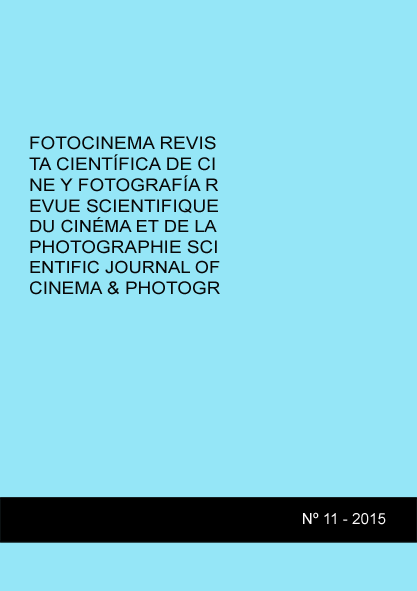Cine, videoclip americano y videoclip japonés: la dirección de arte como hilo conductor. El caso de Not another teen movie
DOI:
https://doi.org/10.24310/Fotocinema.2015.v0i11.6082Abstract
La relación entre cine y videoclip es una cuestión estudiada por los adeptos tanto de una como de otra parte de la ecuación. Estas relaciones suelen abarcar el sentido técnico de ambas materias en tanto que una se nutre de la otra (o la otra de la una); el sentido narrativo donde en ocasiones entra en juego también el propio teatro; el cultural de por qué estas interferencias que con frecuencia ocurren en el ámbito técnico se producen; y, cómo no, el estético.
Sin embargo, se va a dar por sentada de antemano la relación entre el cine y el videoclip en todos estos sentidos al coger como caso un clip que, con motivos promocionales, se ha extraído a conciencia de una película. Este es, el caso del videoclip Tainted Love (2002), protagonizado por Marilyn Manson y dirigido por Phillip G. Atwell, y de la película No es otra estúpida película americana (Not another teen movie, Joel Gallen, 2001). De esta forma, el análisis se focalizará en cómo todos estos “puentes” (técnico, cultural, visual, narrativo) entre uno y otro terminan condensándose al servicio de la imagen y el simbolismo, para volverse a repetir con un motivo meramente artístico1 por un tercer actor promocional: el grupo de visual kei japonés The Gazette, con la canción que da nombre a su videoclip Inside Beast (Toshihiko Imai, 2013).
Abstract:
The relationship between film and video is a matter studied by adherents of both one and the other part of the equation. These relationships tend to cover the technical sense of both subjects while a thrives on the other (or another one); the narrative sense that sometimes enters the game also the theater itself; cultural sense of why these interferences that often occur in the technical field are produced; and, of course, aesthetic sense, also closely linked to the latter, among others.
However, it is taken for granted in advance the relationship between film and video in all these respects to take as a clip case, for promotional purposes, has been extracted from a film confirmed conscience. This is the case of the video Tainted Love (2002), starring Marilyn Manson and directed by Phillip G. Atwell, and film Not Another Teen Movie (Not Another Teen Movie, Joel Gallen, 2001) which is extracts the first. Thus, the analysis will focus on how all these "bridges" (technical, cultural, visual, narrative) between the two end up condensing the service image and symbolism, to go to repeat with a purely artistic motif for Promotional third foreign actor visual kei group The Gazette, with the title track to his video Inside Beast (Toshihiko Imai, 2013).
Palabras clave:
cine; videoclip; dirección de arte; visual kei; publicidad
Keywords:
Cinema; Videoclip; Art Direction; Visual Kei; Advertising
Downloads
Metrics
Downloads
Published
How to Cite
Issue
Section
License
All contents published in Fotocinema Revista científica de cine y fotografía are protected under the Creative Commons Attribution-NonCommercial-ShareAlike 4.0 International (CC BY-NC-SA 4.0) license. All about this license is available in the following link: <http://creativecommons.org/licenses/by-nc-sa/4.0>
Users can copy, use, redistribute, share and exhibit publicly as long as:
- The original source and authorship of the material are cited (Journal, Publisher and URL of the work).
- It is not used for comercial purposes.
- The existence of the license and its especifications are mentioned.
There are two sets of authors’ rights: moral and property rights. Moral rights are perpetual prerogatives, unrenounceable, not-transferable, unalienable, imprescriptible and inembargable. According to authors’ rights legislation, Fotocinema. Revista científica de cine y fotografía recognizes and respects authors moral rights, as well as the ownership of property rights, which will be transferred to University of Malaga in open access. The property rights are referred to the benefits that are gained by the use or the dissemination of works. Fotocinema. Revista científica de cine y fotografía is published in an open access form and it is exclusively licenced by any means for doing or authorising distribution, dissemination, reproduction, , adaptation, translation or arrangement of works.
Authors are responsable for obtaining the necessary permission to use copyrighted images.













13.png)




